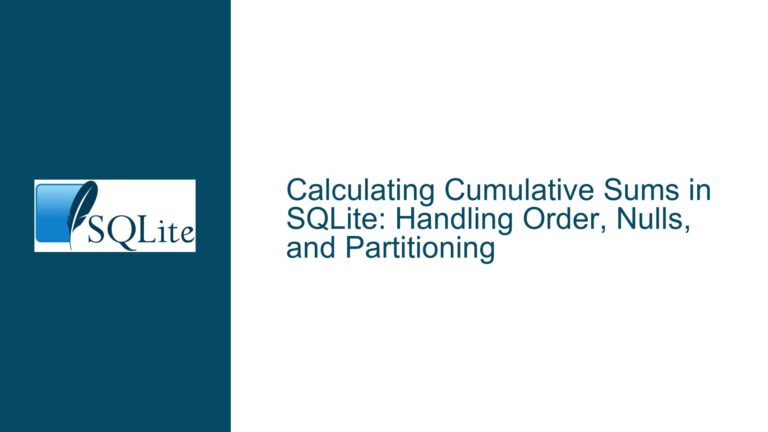Incorrect ISO Week Calculation in SQLite Using strftime(‘%W’)
Understanding ISO Week Calculation and the Role of strftime(‘%W’) in SQLite
The ISO week date system is a standard used to represent weeks in a year, where each week starts on a Monday and the first week of the year is the one that contains at least four days of the new year. This system is widely used in business and international contexts to ensure consistency in week numbering across different regions and systems. In SQLite, the strftime function is commonly used to format dates and extract specific components, such as the week number. However, the behavior of strftime('%W') does not align with the ISO week standard, leading to potential discrepancies in week numbering.
The strftime('%W') function in SQLite returns the week number of the year, where weeks are considered to start on Sunday. This means that the first Sunday of the year marks the beginning of the first week, and any days before that Sunday are considered part of the last week of the previous year. This behavior contrasts with the ISO week standard, where weeks start on Monday, and the first week of the year must contain at least four days of the new year. As a result, using strftime('%W') to calculate ISO week numbers can lead to incorrect results, especially around the boundaries of the year.
For example, if the first day of the year is a Friday, strftime('%W') would consider the first week to start on the following Sunday, which is only two days into the new year. According to the ISO standard, this would not qualify as the first week, as it does not contain at least four days of the new year. This discrepancy can cause confusion and errors in applications that rely on accurate ISO week numbering, such as financial reporting, project management, and scheduling systems.
The Impact of SQLite Version Differences on ISO Week Calculation
The issue of incorrect ISO week calculation using strftime('%W') is further complicated by differences in SQLite versions. In SQLite version 3.40.1 and earlier, the strftime function does not support the %V format specifier, which is specifically designed to return the ISO week number. The %V specifier was introduced in later versions of SQLite to address the limitations of %W and provide a more accurate representation of ISO week numbers.
In environments where older versions of SQLite are used, such as Debian 12, which ships with SQLite 3.40.1, developers may find themselves unable to use %V to calculate ISO week numbers. This limitation can be particularly problematic in legacy systems or environments where upgrading SQLite is not feasible due to compatibility concerns or other constraints. As a result, developers working with older versions of SQLite must rely on alternative methods to calculate ISO week numbers, which may involve more complex queries or custom logic.
The absence of the %V specifier in older SQLite versions means that developers must manually calculate ISO week numbers using the available date and time functions. This process typically involves determining the day of the week for the first day of the year and adjusting the week number accordingly. While this approach can yield accurate results, it requires a deeper understanding of the ISO week standard and the nuances of SQLite’s date and time functions. Additionally, manual calculations increase the risk of errors, especially when dealing with edge cases around the beginning and end of the year.
Workarounds and Solutions for Accurate ISO Week Calculation in Older SQLite Versions
For developers working with older versions of SQLite that do not support the %V specifier, there are several workarounds and solutions available to accurately calculate ISO week numbers. One common approach involves using a combination of strftime('%W') and additional logic to adjust the week number based on the day of the week for the first day of the year. This method leverages the fact that strftime('%W') returns the week number starting on Sunday, and then applies a correction factor to align the result with the ISO week standard.
A practical example of this approach can be seen in the following SQL query, which calculates the ISO week number for a given date stored in the inspection_date column:
SELECT
(strftime('%W', inspection_date) +
(1 - strftime('%W', strftime('%Y', inspection_date) || '-01-04')) AS week
FROM
inspections;
In this query, strftime('%W', inspection_date) returns the week number starting on Sunday, and strftime('%W', strftime('%Y', inspection_date) || '-01-04') calculates the week number for January 4th of the same year. January 4th is chosen because it is always in the first ISO week of the year, regardless of the day of the week on which the year starts. By subtracting the week number of January 4th from 1 and adding it to the week number of the inspection_date, the query effectively adjusts the result to align with the ISO week standard.
This method provides a reliable way to calculate ISO week numbers in older versions of SQLite, but it is important to note that it may not handle all edge cases perfectly. For example, if the inspection_date falls in the last week of the previous year or the first week of the new year, additional logic may be required to ensure accurate results. Developers should thoroughly test their queries with a variety of dates to confirm that the calculated ISO week numbers are correct.
Another approach to calculating ISO week numbers in older SQLite versions involves using a custom function or extension. SQLite supports user-defined functions (UDFs) that can be written in C or other programming languages and loaded into the database. By creating a UDF that implements the ISO week calculation logic, developers can simplify their queries and improve performance. However, this approach requires additional development effort and may not be feasible in all environments, especially those with strict security or resource constraints.
In conclusion, while the lack of the %V specifier in older versions of SQLite presents a challenge for calculating ISO week numbers, there are several workarounds and solutions available. By understanding the nuances of the ISO week standard and leveraging SQLite’s date and time functions, developers can implement accurate and reliable ISO week calculations in their applications. Whether through manual adjustments in SQL queries or custom functions, the key is to carefully consider the edge cases and thoroughly test the implementation to ensure correctness.






